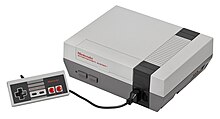Nintendo Famicom
 
Top: Nintendo Entertainment System with controller
Bottom: Nintendo Family Computer ("Famicom") with controller |
|
| Also known as | Family Computer/Famicom (Japan) Hyundai Comboy (Korea) |
|---|---|
| Developer | Nintendo |
| Manufacturer | Nintendo |
| Type | Home video game console |
| Generation | Third generation |
| Release date | |
| Retail availability | 1983–2003 |
| Introductory price |
¥14,800 (Japan) $179 (US Deluxe Set) |
| Discontinued | |
| Units sold | Worldwide: 61.91 million Japan: 19.35 million Americas: 34.00 million Other: 8.56 million |
| Media | ROM cartridge ("Game Pak") |
| CPU | Ricoh 2A03 8-bit processor (MOS Technology 6502 core) |
| Controller input | 2 controller ports 1 expansion slot |
| Best-selling game |
|
| Predecessor | Color TV-Game |
| Successor | Super Nintendo Entertainment System |
The Nintendo Entertainment System (commonly abbreviated as NES) is an 8-bit home video game console that was developed and manufactured by Nintendo. It was initially released in Japan as the Family Computer (Japanese: ファミリーコンピュータ Hepburn: Famirī Konpyūta) (also known by the portmanteau abbreviation Famicom (ファミコン Famikon) and abbreviated as FC) on July 15, 1983, and was later released in North America during 1985, in Europe during 1986 and 1987, and Australia in 1987. In South Korea, it was known as the Hyundai Comboy (현대 컴보이 Hyeondae Keomboi) and was distributed by SK Hynix which then was known as Hyundai Electronics. The best-selling gaming console of its time, the NES helped revitalize the US video game industry following the video game crash of 1983. With the NES, Nintendo introduced a now-standard business model of licensing third-party developers, authorizing them to produce and distribute titles for Nintendo's platform. It was succeeded by the Super Nintendo Entertainment System.
In 2009, the Nintendo Entertainment System was named the single greatest video game console in history by IGN, in a list of 25. It was judged the second greatest console behind the Sega Dreamcast in PC Magazine's "Top 10 Video Game Consoles of All Time".
Following a series of arcade game successes in the early 1980s, Nintendo made plans to create a cartridge-based console called the Famicom, which is short for Family Computer. Masayuki Uemura designed the system. Original plans called for an advanced 16-bit system which would function as a full-fledged computer with a keyboard and floppy disk drive, but Nintendo president Hiroshi Yamauchi rejected this and instead decided to go for a cheaper, more conventional cartridge-based game console as he felt that features such as keyboards and disks were intimidating to non-technophiles. A test model was constructed in October 1982 to verify the functionality of the hardware, after which work began on programming tools. Because 65xx CPUs had not been manufactured or sold in Japan up to that time, no cross-development software was available and it had to be produced from scratch. Early Famicom games were written on a system that ran on an NEC PC-8001 computer and LEDs on a grid were used with a digitizer to design graphics as no software design tools for this purpose existed at that time.
...
Wikipedia

